This post may contain affiliate links. If you buy something through one of these links, we may earn an affiliate commission - at no extra cost to you.
Hello friends!
Now that you know how to make sauerkraut – the classic flavor where all you need is cabbage and salt and caraway seeds, if you’d like, let’s mix things up shall we?
Sometimes all cooking (or in this case fermenting) is is knowing the basics of how to make something and then adding different flavors to mix things up a bit, create your own signature flavor of a recipe. That’s exactly what I’ve done with this sauerkraut!
We’ve got 2 healthy sauerkraut recipes: garlic dill pickle sauerkraut, and carrot ginger lemon sauerkraut. Both super crunchy, tangy, and packed with gut-healthy probiotics. Yet, both have such a different flavor profile. So fun!
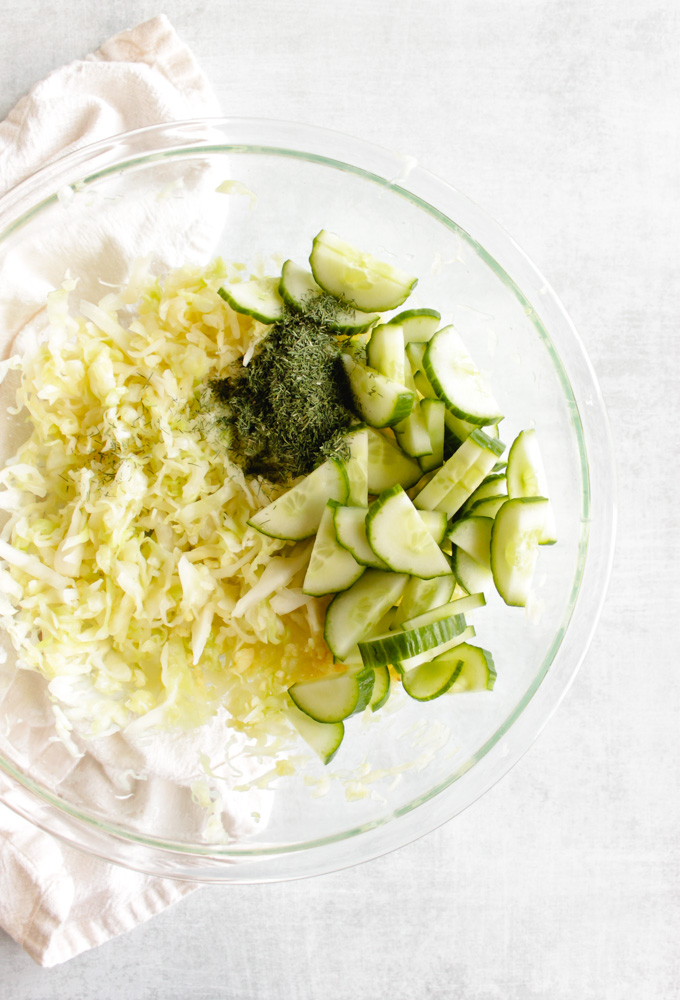
The garlic dill pickle sauerkraut literally tastes like a dill pickle. Raise your hand if you are a dill pickle fanatic!!! Yes, this sauerkraut is perfect for you. Essentially we made sauerkraut with pickles in there.
You can eat the dill pickle sauerkraut on top of anything you would normally love a dill pickle. Think burgers, hot dogs, sandwiches etc. TBH I adore the flavor of the tangy pickles with the dill and a hint of garlic so much that I usually eat it plain, straight out of a bowl.
Fermented heaven, if you ask me!
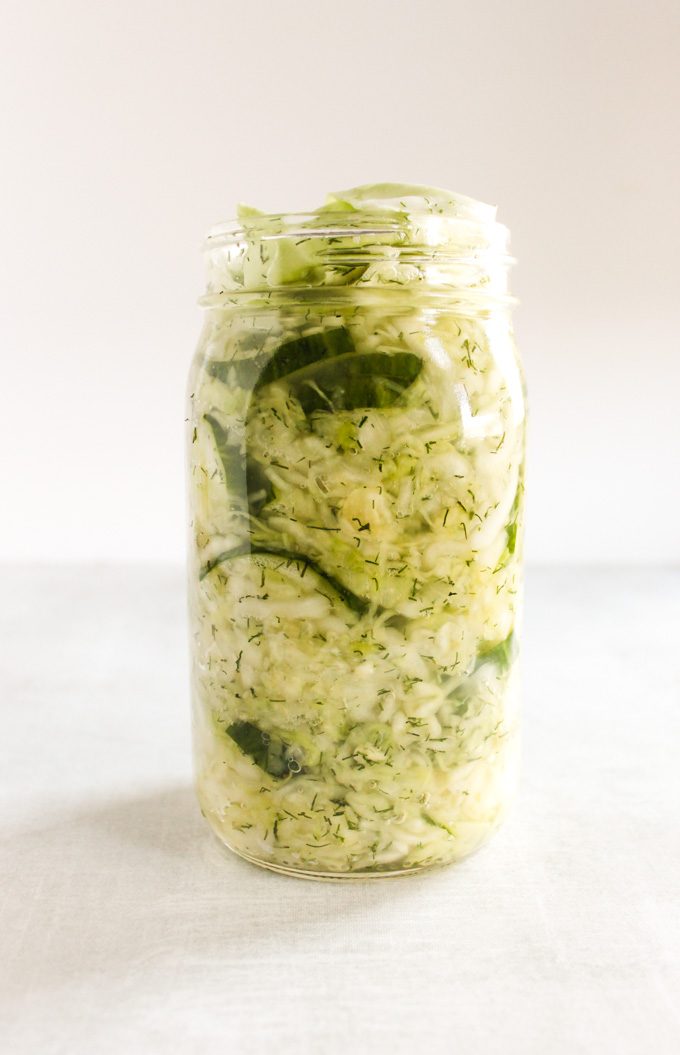
Making up your own healthy sauerkraut recipes is just as easy as making classic sauerkraut. The basic concept of making sauerkraut is exactly the same. The main difference when adding any extra vegetables is you want to keep the other vegetable to a 25% minimum compared to the amount of cabbage used. Otherwise you end up with a slimy kraut, especially if using a vegetable higher in sugar, such as carrots.
Bottom line, less is best when adding any extra vegetables to your sauerkraut.
You can get creative.
A few more healthy sauerkraut recipes I am excited to try are, a beet sauerkraut with red cabbage. Or a turmeric ginger sauerkraut. Maybe an apple ginger sauerkraut with a hint of cinnamon? Also a Mexican inspired sauerkraut with corn, jalapeno, and a little onion. So many options to try out. Have a little fun with your sauerkraut. We are never confined to just one flavor of food.
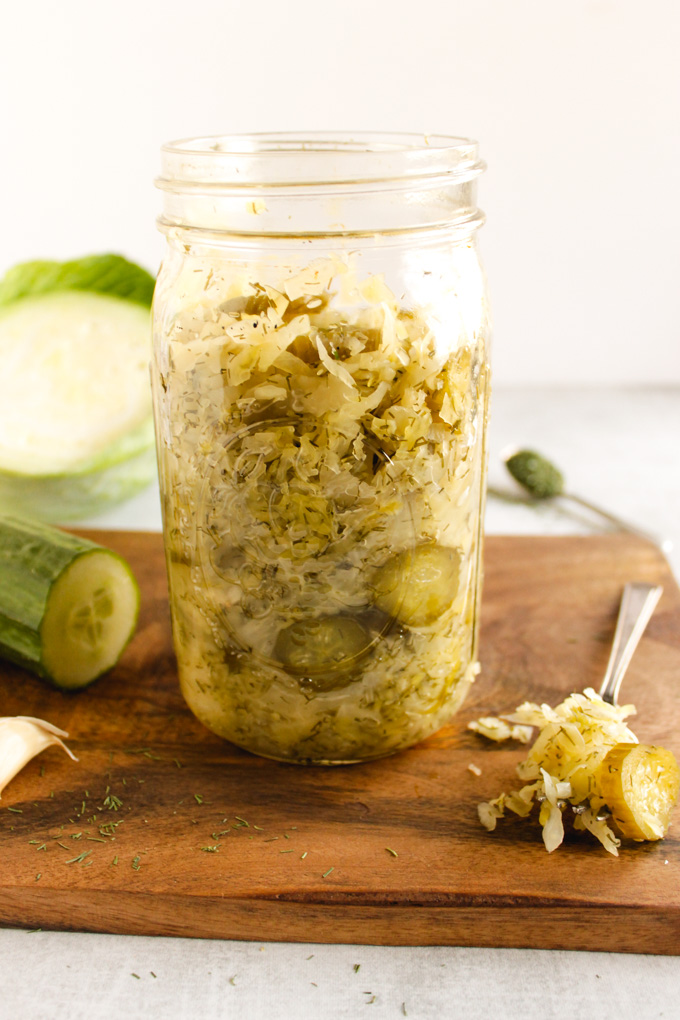
That garlic dill pickle sauerkraut though! I mean look at that cute little pickle waiting to be eaten!
Mouth watering!
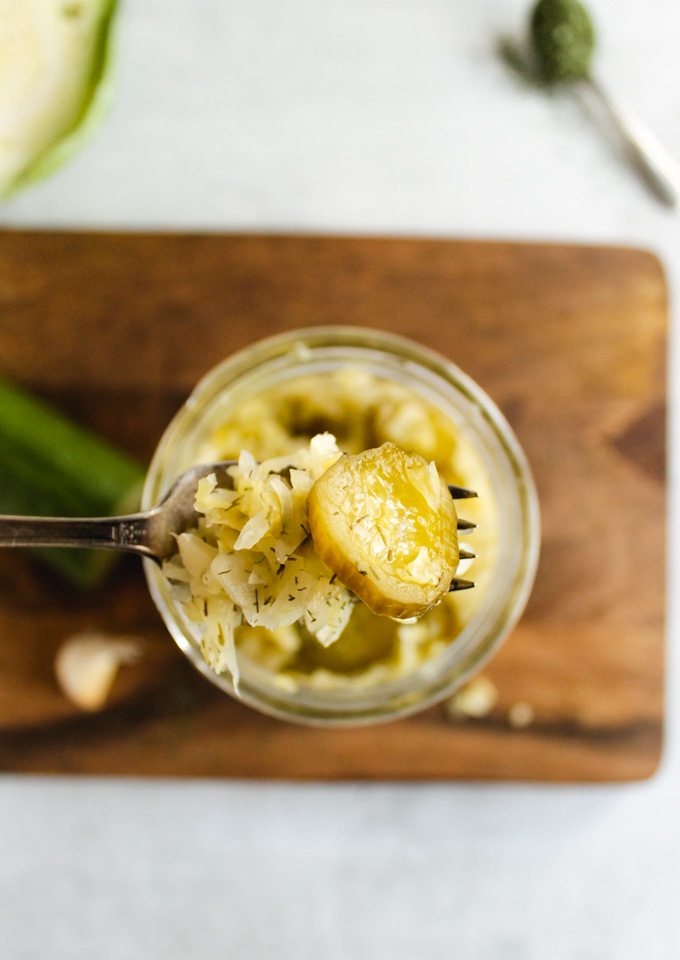
Number two sauerkraut of our 2 healthy sauerkraut recipes is carrot ginger lemon!
This one may seem a little bit strange because we usually tend to think of sauerkraut as more on the savory side and we are adding sweet carrots and lemon rind and fresh spicy ginger. I promise, it’s a nice surprise.
The slight sweetness from the carrots and the spicy ginger and the tangy, chewy lemon rind is sort of an Asian/tropical twist with a nice tang to it. It’s one of a kind.
Even my ginger-hating-husband enjoyed this sauerkraut….in small doses.
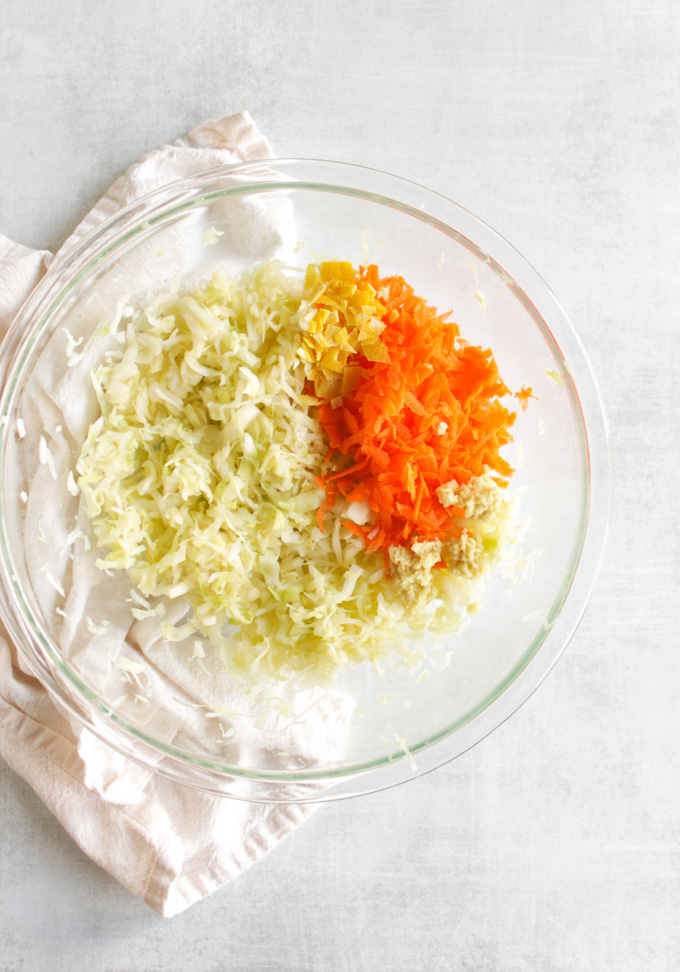
The carrot ginger lemon kraut could be good with any kind of Asian salads or sandwiches. It’s got a slightly sweeter flavor so I wouldn’t imagine it would go well on your traditional burger or hot dog. Honestly, I recommend eating it plain.
Sometimes things are best left to shine on their own.

What I love about this carrot ginger lemon sauerkraut is it’s beautiful sunny orange color.
Also, it’s got some extra digestion benefits from the help of the ginger. All around good for your tummy.
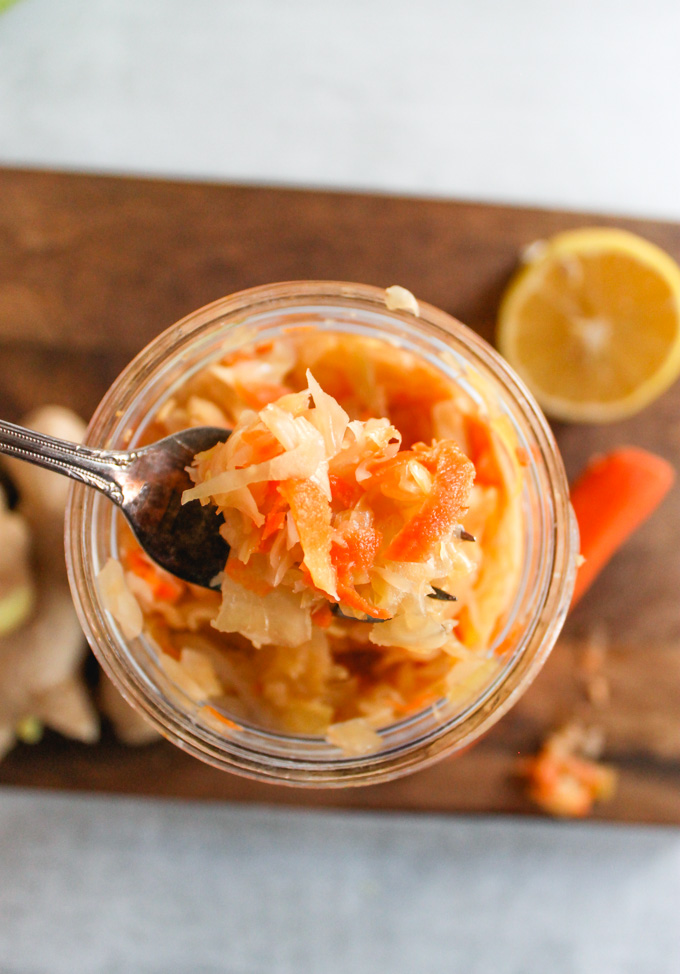
Let me know in the comments below which one of these healthy sauerkraut recipes you decide to make. OR make both, cause you rock like that!
Which one if my healthy sauerkraut recipes is my favorite?
Don’t make me choose! But if you’re only going to make one I would try the garlic dill pickle kraut, especially if you love pickles. The flavor profile is a little more similar to a classic sauerkraut.
TBH the flavor of sauerkraut I make the most is the classic flavor with some caraway seeds. It’s one Paul and I both crave. It’s simple, and goes with almost anything.
That still won’t stop me from playing around with more healthy sauerkraut recipes in the near future. There will be more to come, stay tuned.
For now, enjoy these fun healthy sauerkraut recipes!
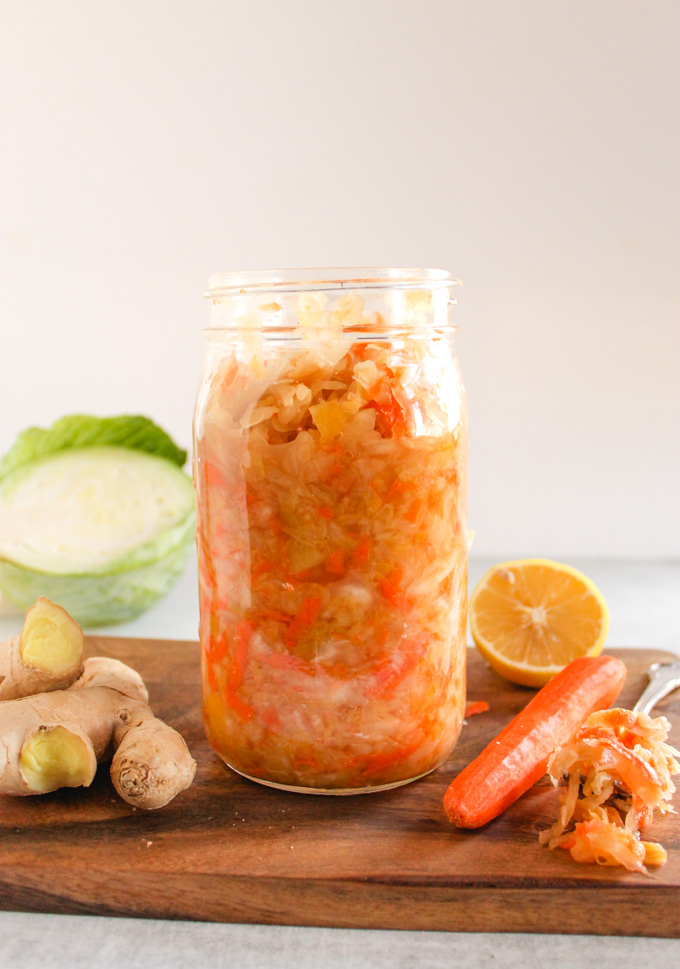
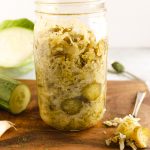
Garlic Dill Pickle Sauerkraut
- Prep Time: 30 mins
- Total Time: 30 mins
- Yield: 24 ounces 1x
- Category: Side, Condiment, Healthy, Easy
- Cuisine: Vegan, Vegetarian, Gluten Free, Dairy Free
Description
Garlic dill pickle sauerkraut is as delicious and tangy as a pickle spear. Easy method for making fermented sauerkraut with probiotics.
Ingredients
- 1 medium head of green cabbage – about 3 pounds
- 1 tablespoon pickling salt or kosher salt*
- 2 mini cucumbers, thinly sliced (or half English/seedless cucumber, cut into half moons)
- 1 tablespoon dried dill (or sub 1 teaspoon fresh dill leaves, chopped)
- 3 garlic cloves, minced
- Tools needed
- 24 ounce wide mouthed mason jar + lid
- parchment paper
- 1 4 ounce jelly jar – without lid
Instructions
- Shred cabbage: Remove the outer leaves of your cabbage, slice it in half and remove the core. Shred your cabbage by either using the slicing blade of a food processor or by using a sharp knife. Transfer the shredded cabbage to a large mixing bowl.
- Massage the cabbage: Add the salt to the shredded cabbage and use clean hands to massage the cabbage until the salt has dissolved and the cabbage has begun to wilt – massage for at least 5 minutes.
- Allow the cabbage to rest: At this point it is helpful to allow the cabbage to rest for 20 to 30 minutes – the salt will continue to draw the liquid out of the cabbage and you will find a lot of liquid at the bottom of the bowl.
- Prepare your mason jar & parchment paper : While the cabbage is resting wash your mason jar and lid well, and jelly jar – no need to sanitize but it should be freshly washed. Cut a piece of parchment paper to fit just inside your mason jar, set aside.
- Massage cabbage again: Returning to the cabbage give it another massage for a minute or two for good measure.
- Add flavors: Toss the cucumbers and give them a quick gentle massage. Then toss in the dill and garlic.
- Stuff cabbage into mason jar: Transfer the cabbage into the mason jar (DO NOT DISCARD ANY LIQUID) – use the back of a wooden spoon or some kind of meddler to help you pack it in tight, it should all fit with about 3 inches of head space, if it doesn’t you need to massage the cabbage more to help it break down. Pour some (or all) of the left behind liquid just so that the cabbage is submerged in liquid. IT’s very important to make sure no pieces of cabbage remain above the liquid, otherwise it will mold.
- Add the parchment paper : Carefully add the parchment paper to rest on top of the cabbage, below the liquid level – this ensures that there are no pieces of cabbage floating outside of the liquid line.
- Add the jelly jar + lid: Next place the jelly jar (without a lid on it) on top of the parchment paper – this acts as a weight to keep everything submerged – screw the mason jar lid onto the 24 ounce wide mouth jar. Slightly unscrew the mason jar lid so that it is secured but not on tight – this allows any gasses to escape from the jar.
- Ferment: For the fun part/the hard part because it requires waiting – Place the jar in a bowl or container to catch any overflow. Find a good fermentation location. Ideal place is 64 to 67 degrees Fahrenheit and not in direct sunlight. The main thing is you don’t want the temperature to be widely inconsistent. My ideal location during the summer is our basement because it stays cool. During the winter my kitchen may work fine if it’s out of the direct sunlight. You want to allow the sauerkraut to ferment for at least 3 to 4 days or up to 2 to 3 weeks – this varies depending on the temperature of your fermentation location and how tangy you personally like the kraut to be.
- Things to watch for: You will want to check on your sauerkraut daily in the first few days. This is what you want to look for. 1) check to make sure the liquid line hasn’t creeped down past the cabbage. If this has happened then you want to mix 1 tablespoon salt to 2 cups of water and use this mixture to top off the cabbage so that it’s submerged again (you will not need to use all of the water salt mixture). 2) check the lid to make sure it’s loose – if the lid isn’t loose the gasses can build up and make the jar explode.
- Signs of fermentation: 1) you see bubbles in the cabbage 2) the cabbage begins to turn from a bright green to a less bright green and eventually to a tan/very mild green (what you see when you think of sauerkraut).
- Taste your sauerkraut: As stated before how long you want your sauerkraut to ferment depends on temperature of location and your personal preference of how tangy it is. I like mine really tangy so I generally allow it to ferment for 2 weeks – I might even go as long as 3 weeks in the winter when the temperature is cooler – warmer temperatures means the fermentation process goes faster. You can start eating the sauerkraut after 3 to 4 days. I suggest you start tasting it at 3 to 4 days and see how you like it and after that taste it every week. Be sure to use a clean fork so you don’t contaminate it. You will know it’s done when it’s tangy and the color of the cabbage has changed to tan/very mild green.
- Store: Once your cabbage has finished fermenting and you’re ready to eat it remove the parchment paper and jelly jar and screw the mason jar lid on tight. Store it in the fridge for up to 3 weeks to a month. Enjoy eating by itself or on sandwiches, salads, burgers, pretty much anything.
Notes
*Salt: In every day cooking I like to use sea salt. After doing some research, and my recipe testing I have found that a salt that doesn’t contain other minerals (such as sea salt) is the best for making sauerkraut. It promotes more fermentation and ultimately a more tangy flavor which means it has more probiotics.
Signs your sauerkraut fermentation went wrong: – if you see any kind of mold, green black, or white – discard the sauerkraut and start over. – If the sauerkraut smells off or tastes bad. Yes, it should have that fermented taste and smell but use your good judgement don’t eat it if it’s not smelling good. – if you see white foam or bubbles on the top that’s usually okay, just use a spoon to scrape it off.
You may notice that in the pictures I had used cabbage leaves to keep the cabbages submerged under the liquid – I didn’t like that method because the cabbage leaves got moldy. I have used several methods of weighting the cabbage under the liquid and have found the parchment paper + empty and lidless jelly jar to work the best.
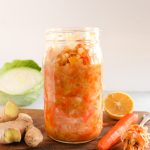
Carrot Ginger Lemon Sauerkraut
- Prep Time: 30 mins
- Total Time: 30 mins
- Yield: 24 ounces 1x
- Category: Side, Condiment, Easy, Healthy
- Cuisine: Vegan, Vegetarian, Gluten Free, Dairy Free
Description
Carrot ginger lemon sauerkraut is a fun Asian twist to it, slightly sweet and ginger-y.Easy method for making fermented sauerkraut with probiotics.
Ingredients
- 1 medium head of green cabbage – about 3 pounds
- 1 tablespoon pickling salt or kosher salt*
- 1 large carrot, peeled and shredded
- 1 lemon
- 1 to 2 inches ginger, grated
- Tools needed
- 24 ounce wide mouthed mason jar + lid
- parchment paper
- 1 4 ounce jelly jar – without lid
Instructions
- Shred cabbage: Remove the outer leaves of your cabbage, slice it in half and remove the core. Shred your cabbage by either using the slicing blade of a food processor or by using a sharp knife. Transfer the shredded cabbage to a large mixing bowl.
- Massage the cabbage: Add the salt to the shredded cabbage and use clean hands to massage the cabbage until the salt has dissolved and the cabbage has begun to wilt – massage for at least 5 minutes.
- Allow the cabbage to rest: At this point it is helpful to allow the cabbage to rest for 20 to 30 minutes – the salt will continue to draw the liquid out of the cabbage and you will find a lot of liquid at the bottom of the bowl.
- Prepare your mason jar & parchment paper : While the cabbage is resting wash your mason jar and lid well, and jelly jar – no need to sanitize but it should be freshly washed. Cut a piece of parchment paper to fit just inside your mason jar, set aside.
- Prepare flavors: Also prepare your flavors – peel and shred the carrot, grate ginger. For the lemon use a vegetable peeler to peel the skin off in large strips and then use a knife to give the rind a rough chop.
- Massage cabbage again: Returning to the cabbage give it another massage for a minute or two for good measure.
- Add flavors: toss the shredded carrot, lemon peel, and ginger into the cabbage.
- Stuff cabbage into mason jar: Transfer the cabbage into the mason jar (DO NOT DISCARD ANY LIQUID) – use the back of a wooden spoon or some kind of meddler to help you pack it in tight, it should all fit with about 3 inches of head space, if it doesn’t you need to massage the cabbage more to help it break down. Pour some (or all) of the left behind liquid just so that the cabbage is submerged in liquid. IT’s very important to make sure no pieces of cabbage remain above the liquid, otherwise it will mold.
- Add the parchment paper : Carefully add the parchment paper to rest on top of the cabbage, below the liquid level – this ensures that there are no pieces of cabbage floating outside of the liquid line.
- Add the jelly jar + lid: Next place the jelly jar (without a lid on it) on top of the parchment paper – this acts as a weight to keep everything submerged – screw the mason jar lid onto the 24 ounce wide mouth jar. Slightly unscrew the mason jar lid so that it is secured but not on tight – this allows any gasses to escape from the jar.
- Ferment: For the fun part/the hard part because it requires waiting – Place the jar in a bowl or container to catch any overflow. Find a good fermentation location. Ideal place is 64 to 67 degrees Fahrenheit and not in direct sunlight. The main thing is you don’t want the temperature to be widely inconsistent. My ideal location during the summer is our basement because it stays cool. During the winter my kitchen may work fine if it’s out of the direct sunlight. You want to allow the sauerkraut to ferment for at least 3 to 4 days or up to 2 to 3 weeks – this varies depending on the temperature of your fermentation location and how tangy you personally like the kraut to be.
- Things to watch for: You will want to check on your sauerkraut daily in the first few days. This is what you want to look for. 1) check to make sure the liquid line hasn’t creeped down past the cabbage. If this has happened then you want to mix 1 tablespoon salt to 2 cups of water and use this mixture to top off the cabbage so that it’s submerged again (you will not need to use all of the water salt mixture). 2) check the lid to make sure it’s loose – if the lid isn’t loose the gasses can build up and make the jar explode.
- Signs of fermentation: 1) you see bubbles in the cabbage 2) the cabbage begins to turn from a bright green to a less bright green and eventually to a tan/very mild green (what you see when you think of sauerkraut).
- Taste your sauerkraut: As stated before how long you want your sauerkraut to ferment depends on temperature of location and your personal preference of how tangy it is. I like mine really tangy so I generally allow it to ferment for 2 weeks – I might even go as long as 3 weeks in the winter when the temperature is cooler – warmer temperatures means the fermentation process goes faster. You can start eating the sauerkraut after 3 to 4 days. I suggest you start tasting it at 3 to 4 days and see how you like it and after that taste it every week. Be sure to use a clean fork so you don’t contaminate it. You will know it’s done when it’s tangy and the color of the cabbage has changed to tan/very mild green.
- Store: Once your cabbage has finished fermenting and you’re ready to eat it remove the parchment paper and jelly jar and screw the mason jar lid on tight. Store it in the fridge for up to 3 weeks to a month. Enjoy eating by itself or on sandwiches, salads, burgers, pretty much anything.
Notes
*Salt: In every day cooking I like to use sea salt. After doing some research, and my recipe testing I have found that a salt that doesn’t contain other minerals (such as sea salt) is the best for making sauerkraut. It promotes more fermentation and ultimately a more tangy flavor which means it has more probiotics.
Signs your sauerkraut fermentation went wrong: – if you see any kind of mold, green black, or white – discard the sauerkraut and start over. – If the sauerkraut smells off or tastes bad. Yes, it should have that fermented taste and smell but use your good judgement don’t eat it if it’s not smelling good. – if you see white foam or bubbles on the top that’s usually okay, just use a spoon to scrape it off.
You may notice that in the pictures I had used cabbage leaves to keep the cabbages submerged under the liquid – I didn’t like that method because the cabbage leaves got moldy. I have used several methods of weighting the cabbage under the liquid and have found the parchment paper + empty and lidless jelly jar to work the best.

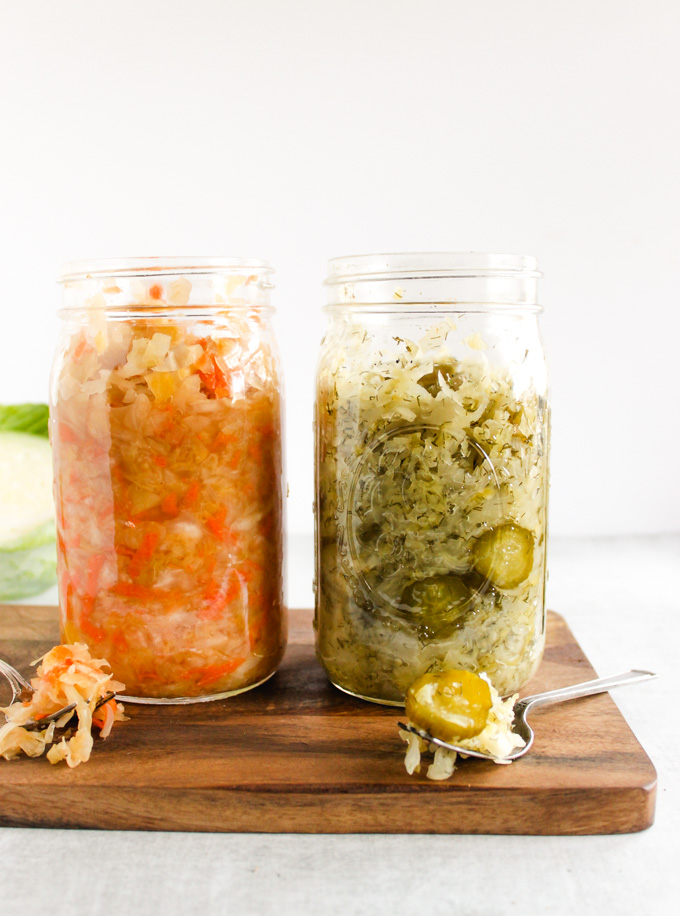

I’ve made the Carrot Ginger Lemon Sauerkraut before and it is delicious. I’ll be trying your recipe soon! I had a “store bought” Whiskey Dill Garlic Sauerkraut one time and fell in love with it. I’d love to try to make. At what point do you think I’d put the Whiskey in in. The whisky taste was so subtle but you could definitely taste it. I was wondering if I would add it at the time of making it or add the whiskey after the ferment but before it’s refrigerated. Any thoughts:
Hi Nancy, I’m so excited that you’re going to make the dill pickle sauerkraut!!!
That whiskey added in there sounds interesting. I would be hesitant to add the whiskey as you make it because the alcohol in it could disrupt the fermentation and growth of the healthy probiotics. I would suggest adding it to the sauerkraut when it is done fermenting and you go to refrigerate it. I still have no idea if this will kill the healthy probiotics or not, but it could be fun to try.
Another idea to try is to boil the whiskey a little bit first, just so that you cook off the alcohol but still retain the flavor. I would still add it to the sauerkraut after it is done fermenting. And make sure the whiskey is cooled too.
I hope this helps. Let me know how it goes. I love whiskey and would be curious to try this! 🙂
I was worried about the alcohol inhibiting the fermentation process too, but the idea of boiling off some alcohol is brilliant. Thanks for the suggestion!
You’re welcome. Let me know how it turns out! 🙂
Woah, I’ve never thought to add pickles to sauerkraut!! Why have I never thought of this!? I’m a huge dill pickle fan and I’m definitely intrigued. Thanks for another good idea 🙂 I’m loving going through your website!
The pickles in that sauerkraut are SO good!!!
It’s great to hear that you are enjoying my blog Miranda. Thanks for the sweet comments. 🙂